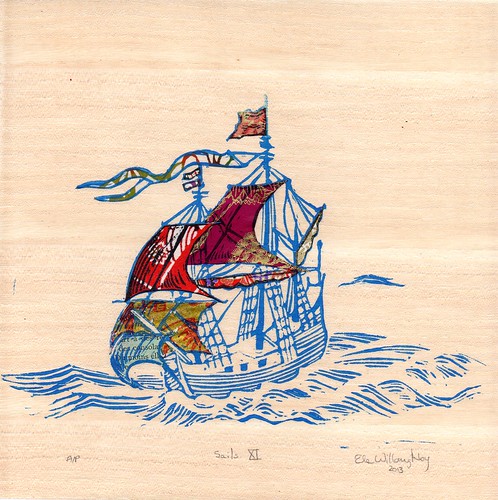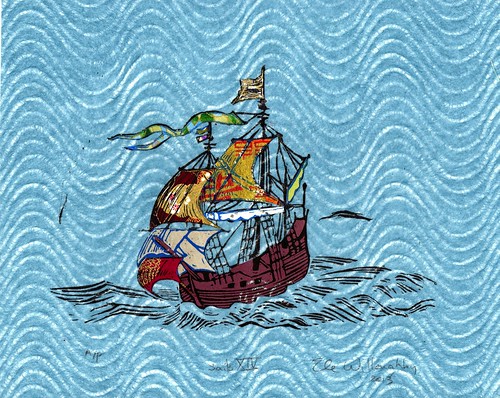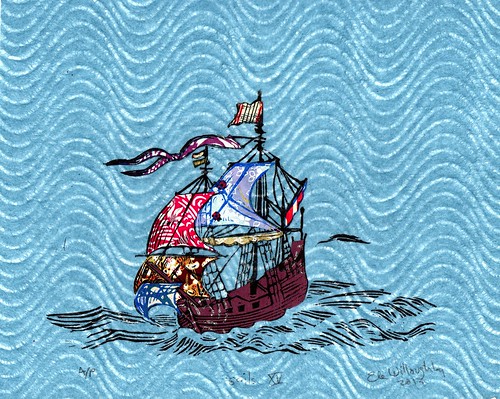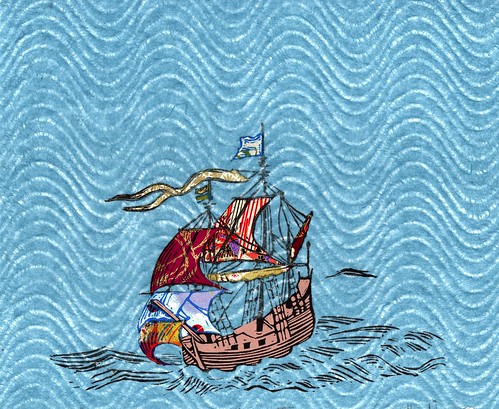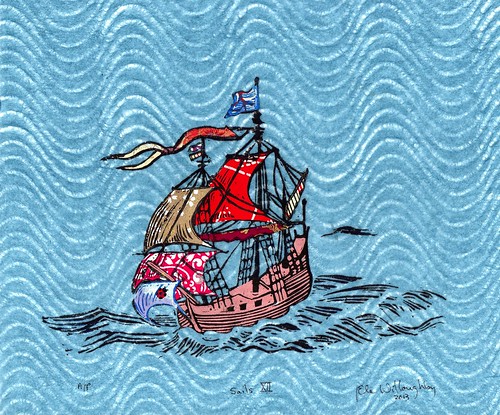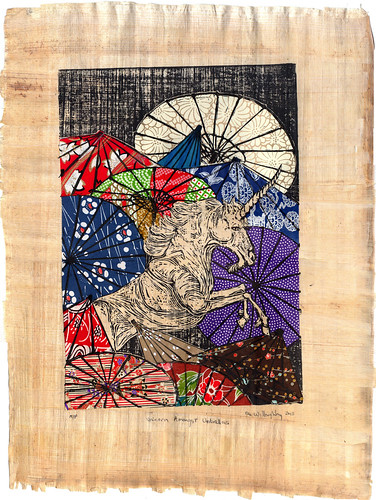 Today is the fifth annual international day of blogging to celebrate the achievements of women in technology, science and math, Ada Lovelace Day 2013 (ALD13). I'm sure you'll all recall, Ada, brilliant proto-software engineer, daughter of absentee father, the mad, bad, and dangerous to know, Lord Byron, she was able to describe and conceptualize software for Charles Babbage's computing engine, before the concepts of software, hardware, or even Babbage's own machine existed! She foresaw that computers would be useful for more than mere number-crunching. For this she is rightly recognized as visionary - at least by those of us who know who she was. She figured out how to compute Bernouilli numbers with a Babbage analytical engine. Tragically, she died at only 36. Today, in Ada's name, people around the world are blogging
Today is the fifth annual international day of blogging to celebrate the achievements of women in technology, science and math, Ada Lovelace Day 2013 (ALD13). I'm sure you'll all recall, Ada, brilliant proto-software engineer, daughter of absentee father, the mad, bad, and dangerous to know, Lord Byron, she was able to describe and conceptualize software for Charles Babbage's computing engine, before the concepts of software, hardware, or even Babbage's own machine existed! She foresaw that computers would be useful for more than mere number-crunching. For this she is rightly recognized as visionary - at least by those of us who know who she was. She figured out how to compute Bernouilli numbers with a Babbage analytical engine. Tragically, she died at only 36. Today, in Ada's name, people around the world are blogging
I've been thinking for a while about whom I would like to portray, in a new print, and write about for Ada Lovelace Day.
Emmy Noether has been on my 'to do' list for a while.
When I was taught
Noether's Theorem, which related symmetries to conservation laws, I was absolutely flabbergasted. It's one of the most profound ideas in physics (and hence a pretty fundamental aspect of the universe as we know it). It's downright astounding that she isn't a household name (and remember, we do know the names of many male theoreticians even if an understanding of their work is uncommon). I experienced one of those - perhaps transcendental - flashes of insight where I suddenly 'saw' how the theorem was true. I think those moments actual explain why many people choose to be scientists; there's nothing like it. I don't know that I can explain it fully and I'm not sure I can explain the beauty of
Noether's Theorem without spontaneously trying to teach anyone willing to listen a term of classical mechanics. I definitely do not know how to convey its meaning in a portrait... though as you can see from my portrait of
Lady Ada Lovelace that I am willing to carve actual equations (in reverse, no less!) to show what a person accomplished, but the fact is that even if you do not understand the computation of
Bernouilli numbers the meaning of the print is conveyed; Ada showed how the calculations could be done mechanically, on
Charles Babbage's wondrous computing engine. To really let anyone understand Noether's tremendous accomplishment, I would need to make
Noether's Theorem transparent... though I'm sure most artists would not feel constrained by this requirement. As I've yet to figure out how to do so, I wanted to select someone's whose achievements were more accessible and obvious to understand.
Mary Anning (21 May 1799 – 9 March 1847) was the wrong class, the wrong sex and even the wrong religious denomination to gain the education, opportunity to work and communicate her results or to garner any respect as a pioneering paleontologist. Further, during her lifetime most people in Britain and elsewhere thought the Earth was a mere few thousand years old, based on a very literal interpretation of the Bible and found the idea of extinction did not fit in with the story of creation. Yet, her fossil discoveries, meticulous collection, documentation and independent work to fully understand the anatomy of the amazing Jurassic creatures she encountered in famed
Blue Lias cliffs of Lyme Regis, Dorset, England, were so undeniable that she gained the recognition, admiration and respect of the paleontologists of the day. Others working in the field at the time were almost uniformly male, upper class and Anglican - most of them in fact were clergymen; while Dissenters like Anning were banned from university, the army and several professions. It's hard to fathom today the way that the contributions of working class people could be blatantly ignored or appropriated by their so-called 'betters'. During her lifetime she was barred from even attending meetings of the
Geological Society of London (let alone applying for membership) because of her sex and many wealthy "paleontologists" published claims of discovery based on having purchased fossils from Anning and other working class fossil hunters (neglecting to mention Anning's name or contribution). Nonetheless, many contemporary geologists and paleontologists became so impressed with her knowledge that they would visit her to consult on the anatomy and classification of fossil finds as well as collaborate on what we would today call field studies, including her friend
Henry De la Beche, William Buckland (who acknowledged her role in recognizing the significance of coprolite to the Geological Society),
Richard Owen,
Thomas Hawkins (whom she chastised for 'enhancing' his fossil skeletons by mixing finds before this unscientific habit resulted in scandal),
Roderick Murchison, the famed Swiss palaeontologist
Louis Agassiz (who thanked her in his book
Studies of Fossil Fish, and named two species in her honour)
. She corresponded with the foremost geologists of her day,
Charles Lyell, and
Adam Sedgwick who taught Darwin.

Her family was poor and her parents struggled with adequately support their 10 children (only two of whom survived infancy and childhood). Mary's formal education only included reading and writing which she was taught by the local Congregationalist school. Her father was a cabinet maker (who tragically died young) who like other locals supplemented his income by selling 'curios' to tourists, which were mainly
ammonite fossils called 'snake stones' at the time. I've shown two of these spiral, fossil shells of these extinct cephalopods in my print. Mary made her living by selling fossils from a small roadside stand and ultimately a small store she set up in her home. She made her first significant
find, the first
ichthyosaur skeleton to be correctly identified, with her brother Joseph when she was only 12 years old.
I've shown Mary Anning standing in front of the Blue Lias cliffs in front of an ichthyosaur skeleton, like the one she painstakingly excavated. She discovered and excavated the the first two
plesiosaur skeletons ever found and the first
pterosaur skeleton located outside Germany as well as many important fossil fish. I've also taken the artistic license to show a
plesiosaurus fossil above her, based on one she herself found. The cliffs I've illustrated are so packed with fossils, not to underplay the work of finding these fossils, but to try and illustrate the some of the huge scope of her finds. She also worked on invertebrates. Her research showed that
belemnite fossils contained fossilised
ink sacs like those of modern
cephalopods. She was also the first to recognize that
coprolites, known as
bezoar stones at the time, were fossilised... well, animal droppings (feces). While this sounds distinctly unglamorous, the study of coprolites pioneered by Anning and Buckland were vital to understanding ancient ecosystems. Her friend
Henry De la Beche painted the
first widely circulated representation of a prehistoric (deep time) scene, based on her finds, and he sold prints to benefit her financially.
Despite her limited formal education she read the scientific literature of the day, copying technical anatomical diagrams and made her own dissections of animals to make comparative studies with her fossil finds. Despite the many barriers to her, she did succeed in having her 1839 letter to the editor
Magazine of Natural History published, which corrected an erroneous claim about the classification of extinct sharks.
Gathering fossils along the cliffs, especially following storms when new fossils could be found due to the recent erosion and during the winter months was dangerous work. The tides could come in quickly and the cliffs were not always stable. She narrowly escaped being crushed in a landslide which claimed the life of her faithful dog Tray.

Though she resented the way her own work was ignored or appropriated by others, she did become increasingly well-known, as her life advanced and posthumously. She struggled financially for most of her life, and she did receive help from colleagues who held her in high esteem. Nine years before her death she was given an annuity, raised by members of the British Association for the Advancement of Science and the Geological Society of London. After she was diagnosed with cancer, in 1846 the Geological Society raised money from its members to help with her expenses and the council of the newly created
Dorset County Museum made her an honorary member. When she died,
Henry De la Beche wrote and read her eulogy at a Geological Society meeting beginning,
"I cannot close this notice of our losses by death without advertising to that of one, who though not placed among even the easier classes of society, but one who had to earn her daily bread by her labour, yet contributed by her talents and untiring researches in no small degree to our knowledge of the great Enalio-Saurians, and other forms of organic life entombed in the vicinity of Lyme Regis ..."
Members of the Society commissioned stained glass windows in her parish church in her memory.
Charles Dickens wrote of her in 1865 that "[t]he carpenter's daughter has won a name for herself, and has deserved to win it."
She has since been recognized for her scientific contributions by the Royal Society, paleontologists, geologists, historians of science and even in some popular culture. It is often repeated that she is the subject of the well-known tongue-twister
She sells seashells on the seashore
The shells she sells are seashells, I'm sure
So if she sells seashells on the seashore
Then I'm sure she sells seashore shells.
but there is no solid evidence to support this; in fact, this is likely metafolklore, a folktale about a tongue twister. She appears in in
The French Lieutenant's Woman (1969) by
John Fowles, and she is the subject of the historical novels
Remarkable Creatures (2009) by
Tracy Chevalier and
Curiosity (2010) by Joan Thomas.
This post contains much information from the remarkably thorough wikipedia entry on Mary Anning, the Natural History Museaum biography of Mary Anning (which calls her "the greatest fossil hunter ever known") and though it was a novel and takes some license with personal relationships for the sake of an engaging story, the very enjoyable 'Curiosity' (2010) by Joan Thomas (which I reviewed here). Edited August 26, 2023 to correct myth about tongue twister.









